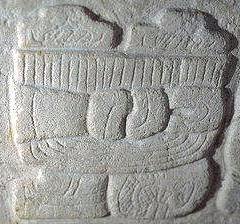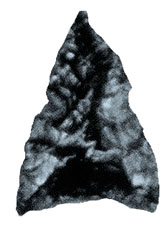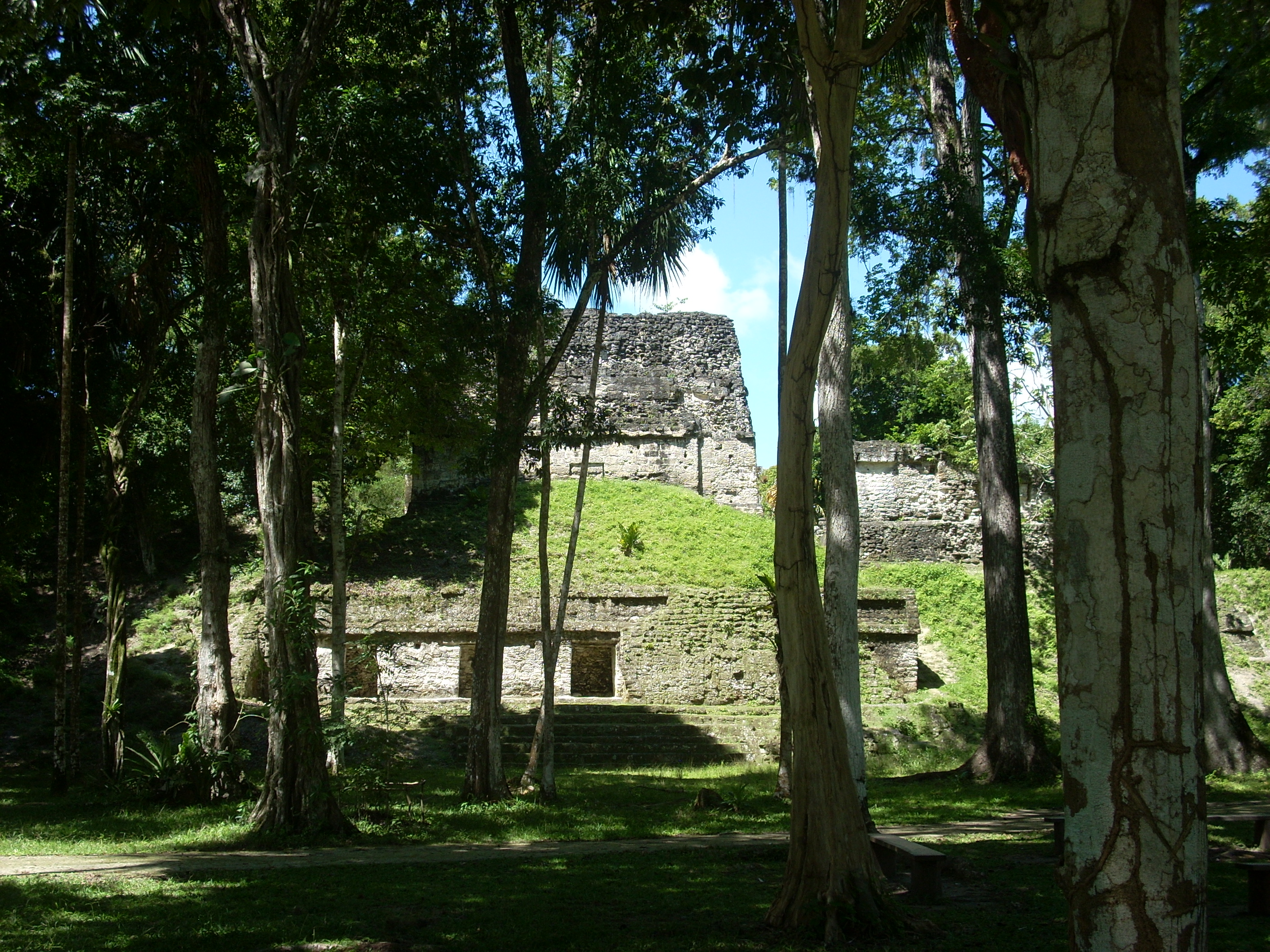|
Plaza Of The Seven Temples
The Plaza of the Seven Temples (or ''Plaza de los Siete Templos'' in Spanish) is an architectural complex in the ruins of the Maya city of Tikal, in the Petén Department of northern Guatemala. It is to the south of Temple III and to the west of the South Acropolis; it is to the southwest of the Great Plaza.Gómez 2006, p.768. The Plaza of the Seven Temples is situated directly to the east of the ''Mundo Perdido'' ("Lost World") Complex and takes its name from a row of seven small temples dating to the Late Classic Period (600–900 AD).Torres 1996, p.299. Coe 1967, 1988, p.88. The plaza has a surface area of approximately , making it one of the three largest plazas in the city.Gómez 2007, p.492. History Preclassic Two deposits of Middle Preclassic ceramic fragments were excavated in the southwest portion of the plaza. Each deposit consisted of thousands of fragments that had been placed in hollows carved in the limestone bedrock below the plaza.Gómez 2006, p.778. Th ... [...More Info...] [...Related Items...] OR: [Wikipedia] [Google] [Baidu] |
Plaza Of The Seven Temples - Structure 5D-96
A town square (or square, plaza, public square, city square, urban square, or ''piazza'') is an open public space, commonly found in the heart of a traditional town but not necessarily a true square, geometric square, used for community gatherings. Related concepts are the civic center, the market square and the village green. Most squares are hardscapes suitable for open market (place), markets, concerts, political rallies, and other events that require firm ground. Being centrally located, town squares are usually surrounded by small shops such as bakeries, meat markets, cheese stores, and clothing stores. At their center is often a water well, well, monument, statue or other feature. Those with fountains are sometimes called fountain squares. By country Australia The Adelaide city centre, city centre of Adelaide and the adjacent suburb of North Adelaide, in South Australia, were planned by Colonel William Light in 1837. The city streets were laid out in a grid plan, with t ... [...More Info...] [...Related Items...] OR: [Wikipedia] [Google] [Baidu] |
Tikal Plaza Of The Seven Temples 2
Tikal () (''Tik’al'' in modern Mayan orthography) is the ruin of an ancient city, which was likely to have been called Yax Mutal, found in a rainforest in Guatemala. It is one of the largest archeological sites and urban centers of the pre-Columbian Maya civilization. It is located in the archeological region of the Petén Basin in what is now northern Guatemala. Situated in the department of El Petén, the site is part of Guatemala's Tikal National Park and in 1979 it was declared a UNESCO World Heritage Site. Tikal was the capital of a conquest state that became one of the most powerful kingdoms of the ancient Maya. Though monumental architecture at the site dates back as far as the 4th century BC, Tikal reached its apogee during the Classic Period, c. 200 to 900. During this time, the city dominated much of the Maya region politically, economically, and militarily, while interacting with areas throughout Mesoamerica such as the great metropolis of Teotihuacan in th ... [...More Info...] [...Related Items...] OR: [Wikipedia] [Google] [Baidu] |
Obsidian Use In Mesoamerica
Obsidian is a naturally formed volcanic glass that was an important part of the material culture of Pre-Columbian Mesoamerica. Obsidian was a highly integrated part of daily and ritual life, and its widespread and varied use may be a significant contributor to Mesoamerica's lack of metallurgy. Lithic and contextual analysis of obsidian, including source studies, are important components of archaeological studies of past Mesoamerican cultures and inform scholars on economy, technological organization, long-distance trade, ritual organization, and socio-cultural structure. Production techniques Due to its glassy internal structure, obsidian is relatively easy to work, as it breaks in very predictable and controlled ways via conchoidal fracturing. This contributed to its prolific use throughout Mesoamerica. It is obtained by either quarrying source sites or in nodule form from riverbeds or fractured outcrops. Following the removal of cortex (when applicable), bifacial, uni ... [...More Info...] [...Related Items...] OR: [Wikipedia] [Google] [Baidu] |
Jade Use In Mesoamerica
The use of jade in Mesoamerica for symbolic and ideological ritual was highly influenced by its rarity and value among pre-Columbian Mesoamerican cultures, such as the Olmec, the Maya, and the various groups in the Valley of Mexico. Although jade artifacts have been created and prized by many Mesoamerican peoples, the Motagua River valley in Guatemala was previously thought to be the sole source of jadeite in the region. This extreme durability makes fine grained or fibrous jadeite and nephrite highly useful for Mesoamerican technology. It was often worked or carved as ornamental stones, a medium upon which glyphs were inscribed, or shaped into figurines, weapons, and other objects. Many jade artifacts crafted by later Mesoamerican civilizations appear cut from simple jade axes, implying that the earliest jadeite trade was based in utilitarian function. Jade and Jadeite In general terms, jade refers to two distinct minerals: nephrite, a calcium and magnesium rich amphibole mi ... [...More Info...] [...Related Items...] OR: [Wikipedia] [Google] [Baidu] |
Roof Comb
Roof comb (or roof-comb) is the structure that tops a pyramid in monumental Mesoamerican architecture. Examination of the sections and iconography of Maya civilization roof-combs indicates that each icon had specific sacred meanings. Typically, the roof combs crowned the summit of pyramids and other structures; they consisted of two pierced framework walls which leaned on one another. This framework was covered by plaster decorated with artist depictions of gods or important rulers. History and significance The Mayans engineered some of the most important monuments in Mesoamerica. Their civilization experienced its ‘golden age’ between 500 and 900 AD. Recent deciphering of Maya hieroglyphs has brought new understanding to their architecture; these pictographic symbols tell historians about when specific structures were built and by whom. In Mayan religious architecture there was an emphasis on height, which was often manifested by vertiginous staircases that reached towa ... [...More Info...] [...Related Items...] OR: [Wikipedia] [Google] [Baidu] |
Plaza Of The Seven Temples, Tikal 06
A town square (or square, plaza, public square, city square, urban square, or ''piazza'') is an open public space, commonly found in the heart of a traditional town but not necessarily a true geometric square, used for community gatherings. Related concepts are the civic center, the market square and the village green. Most squares are hardscapes suitable for open markets, concerts, political rallies, and other events that require firm ground. Being centrally located, town squares are usually surrounded by small shops such as bakeries, meat markets, cheese stores, and clothing stores. At their center is often a well, monument, statue or other feature. Those with fountains are sometimes called fountain squares. By country Australia The city centre of Adelaide and the adjacent suburb of North Adelaide, in South Australia, were planned by Colonel William Light in 1837. The city streets were laid out in a grid plan, with the city centre including a central public s ... [...More Info...] [...Related Items...] OR: [Wikipedia] [Google] [Baidu] |
Tikal Plaza Of The Seven Temples Reconstruction
Tikal () (''Tik’al'' in modern Mayan orthography) is the ruin of an ancient city, which was likely to have been called Yax Mutal, found in a rainforest in Guatemala. It is one of the largest archeological sites and urban centers of the pre-Columbian Maya civilization. It is located in the archeological region of the Petén Basin in what is now northern Guatemala. Situated in the department of El Petén, the site is part of Guatemala's Tikal National Park and in 1979 it was declared a UNESCO World Heritage Site. Tikal was the capital of a conquest state that became one of the most powerful kingdoms of the ancient Maya. Though monumental architecture at the site dates back as far as the 4th century BC, Tikal reached its apogee during the Classic Period, c. 200 to 900. During this time, the city dominated much of the Maya region politically, economically, and militarily, while interacting with areas throughout Mesoamerica such as the great metropolis of Teotihuacan in th ... [...More Info...] [...Related Items...] OR: [Wikipedia] [Google] [Baidu] |
Relief
Relief is a sculptural method in which the sculpted pieces are bonded to a solid background of the same material. The term '' relief'' is from the Latin verb ''relevo'', to raise. To create a sculpture in relief is to give the impression that the sculpted material has been raised above the background plane. When a relief is carved into a flat surface of stone (relief sculpture) or wood ( relief carving), the field is actually lowered, leaving the unsculpted areas seeming higher. The approach requires a lot of chiselling away of the background, which takes a long time. On the other hand, a relief saves forming the rear of a subject, and is less fragile and more securely fixed than a sculpture in the round, especially one of a standing figure where the ankles are a potential weak point, particularly in stone. In other materials such as metal, clay, plaster stucco, ceramics or papier-mâché the form can be simply added to or raised up from the background. Monumental bronze relief ... [...More Info...] [...Related Items...] OR: [Wikipedia] [Google] [Baidu] |
Maya Stelae
Maya stelae (singular ''stela'') are monuments that were fashioned by the Maya civilization of ancient Mesoamerica. They consist of tall, sculpted stone shafts and are often associated with low circular stones referred to as altars, although their actual function is uncertain. Many stelae were sculpted in low relief, although plain monuments are found throughout the Maya region. The sculpting of these monuments spread throughout the Maya area during the Classic Period (250–900 AD), and these pairings of sculpted stelae and circular altars are considered a hallmark of Classic Maya civilization. The earliest dated stela to have been found '' in situ'' in the Maya lowlands was recovered from the great city of Tikal in Guatemala. During the Classic Period almost every Maya kingdom in the southern lowlands raised stelae in its ceremonial centre. Stelae became closely associated with the concept of divine kingship and declined at the same time as this institution. The production ... [...More Info...] [...Related Items...] OR: [Wikipedia] [Google] [Baidu] |
Tikal Plaza Of The Seven Temples
The Plaza of the Seven Temples (or ''Plaza de los Siete Templos'' in Spanish) is an architectural complex in the ruins of the Maya city of Tikal, in the Petén Department of northern Guatemala. It is to the south of Temple III and to the west of the South Acropolis; it is to the southwest of the Great Plaza.Gómez 2006, p.768. The Plaza of the Seven Temples is situated directly to the east of the ''Mundo Perdido'' ("Lost World") Complex and takes its name from a row of seven small temples dating to the Late Classic Period (600–900 AD).Torres 1996, p.299. Coe 1967, 1988, p.88. The plaza has a surface area of approximately , making it one of the three largest plazas in the city.Gómez 2007, p.492. History Preclassic Two deposits of Middle Preclassic ceramic fragments were excavated in the southwest portion of the plaza. Each deposit consisted of thousands of fragments that had been placed in hollows carved in the limestone bedrock below the plaza.Gómez 2006, p.778. Th ... [...More Info...] [...Related Items...] OR: [Wikipedia] [Google] [Baidu] |
E-Group
E-Groups are unique architectural complexes found among a number of ancient Maya settlements. They are central components to the settlement organization of Maya sites and, like many other civic and ceremonial buildings, could have served for astronomical observations. It has been a common opinion that the alignments incorporated in these structural complexes correspond to the sun's solstices and equinoxes. Recent research has shown, however, that the orientations of these assemblages are highly variable, but pertain to alignment groups that are widespread in the Maya area and materialized mostly in other types of buildings, recording different agriculturally significant dates. Origin of the name E-Groups are named after "Group E" at the Classic period site of Uaxactun, which was the first one documented by Mesoamerican archaeologists. At Uaxactun, the Group E complex consists of a long terraced platform with three supra-structures arranged along a linear axis oriented north ... [...More Info...] [...Related Items...] OR: [Wikipedia] [Google] [Baidu] |
Mesoamerican Ballcourt
A Mesoamerican ballcourt ( nah, tlachtli) is a large masonry structure of a type used in Mesoamerica for over 2,700 years to play the Mesoamerican ballgame, particularly the hip-ball version of the ballgame. More than 1,300 ballcourts have been identified, 60% in the last 20 years alone. Although there is a tremendous variation in size, in general all ballcourts are the same shape: a long narrow alley flanked by two walls with horizontal, vertical, and sloping faces. Although the alleys in early ballcourts were open-ended, later ballcourts had enclosed end-zones, giving the structure an -shape when viewed from above. Ballcourts were also used for functions other than, or in addition to, ballgames. Ceramics from western Mexico show ballcourts being used for other sporting endeavours, including what appears to be a wrestling match. It is also known from archaeological excavations that ballcourts were the sites of sumptuous feasts, although whether these were conducted in the contex ... [...More Info...] [...Related Items...] OR: [Wikipedia] [Google] [Baidu] |








